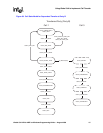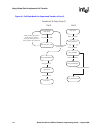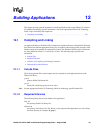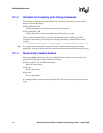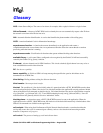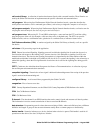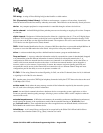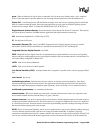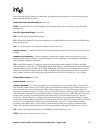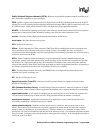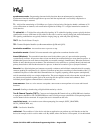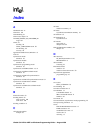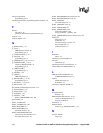
Global Call API for HMP on Windows Programming Guide — August 2006 145
DDI string: A string of Direct Dialing In digits that identifies a called number.
DLL (Dynamically Linked Library): In Windows environments, a sequence of instructions, dynamically
linked at runtime and loaded into memory when they are needed. These libraries can be shared by several processes.
device: Any computer peripheral or component that is controlled through a software device driver.
device channel: An Intel® Dialogic® data path that processes one incoming or outgoing call at a time. Compare
to time slot.
digital channel: Designates a bi-directional transfer of data for a single time slot of a T1 or an E1 digital frame
between a T1/E1 device that connects to the digital service and the SCbus. Digitized information from the T1/E1
device is sent to the SCbus over the digital transmit channel. The response to this call is sent from the SCbus to the
T1/E1 device over the digital receive (listen) channel.
DNIS: Dialed Number Identification Service. A feature of 800 lines that allows a system with multiple 800 lines in
its queue to access the 800 number the caller dialed. Also provides caller party number information.
driver: A software module that provides a defined interface between a program and the hardware.
Drop and Insert: 1. A process where the information carried by a transmission system is demodulated (dropped)
at an intermediate point and different information is entered (inserted) for subsequent transmission. 2. A
configuration in which two network interface resources are connected via an internal bus, such as the SCbus, to
connect calls from one network interface to the other. A call from one network interface can be dropped to a
resource, such as a voice resource, for processing. In return, the resource can insert signaling and audio and
retransmit this new bit stream via the internal bus and connect the call to a different channel. Drop and insert
configurations provide the ability to access an operator or another call.
E1 CAS: E1 line using Channel Associated Signaling. In CAS, one of the 32 channels (time slot 16) is dedicated
to signaling for all of the 30 voice channels.
E1: Another name given to the CEPT digital telephony format devised by the CCITT that carries data at the rate of
2.048 Mbps (DS-1 level).
en-bloc mode: Mode where the setup message contains all the information required by the network to process
the call, such as the called party address information.
event: An unsolicited communication from a hardware device to an operating system, application, or driver.
Events are generally attention-getting messages, allowing a process to know when a task is complete or when an
external event occurs.
extended asynchronous: In Windows environments, the extended asynchronous (multithread asynchronous)
model extends the features of the asynchronous model with the extended functions, sr_WaitEvtEx( ) and
gc_GetMetaEventEx( ). These extended functions allow an application to run different threads, wherein each
thread handles the events from a different device.
failed library: A call control library configured to be recognized by the Global Call API and which did not
successfully start when the Global Call gc_Start( ) function was issued.



